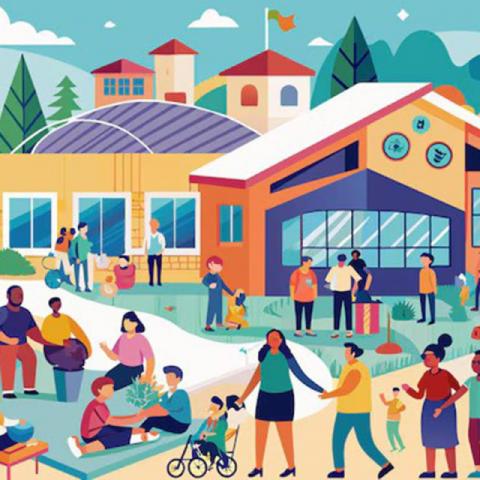Collaborative Strength of School, Family and Community in Education
OF course, education looks like the united states where schools, families and communities are concentrated, figuratively. Most administrators have consistently recognized the importance of effective school-family-community collaboration and the desirability of maintaining good public relations in education. School-family-community collaboration should be a cooperative process which is both honest and responsive.
If a school wants to be a good and safe atmosphere, family and community involvement with the school must be enhanced. Correctly done, the collaboration improves schools, strengthens families as well as neighbourhoods, and leads to a marked reduction in youth problems. Poorly implemented collaboration can, however, end up being another reformed effort that promised a lot, did little good and even did some harm. Strong school-family-community partnerships are critical in impoverished communities where schools are often the most prominent pieces of public real estate and may also be the single largest employer. Although it is relatively simple to make informal links, establishing a major long-term collaboration is complicated. The complications are readily seen in any effort to develop a comprehensive, multifaceted and integrated approach to promoting healthy development and addressing barriers to growth as well as learning. System changes are too required to improve and evolve formally institutionalized sharing of a broad spectrum of responsibilities and resources.
Building comprehensive collaboration calls for stakeholder readiness, cohesive policy, an enlightened vision, creative leadership, and newly multifaceted roles for professionals who work in schools and communities, as well as for family and other community members who are willing to assume leadership. As noted, in connecting families, schools and communities, the hope is that integrated resources will have a greater impact not only on meeting at-risk factors but also on providing all-round development. In fact, collaboration is often established due to the desire to address a local problem or in the wake of a crisis. However, in the long run, school-family-community collaboration must be driven by a comprehensive vision of strengthening youngsters, families, schools and neighbourhoods. Such cooperation is about building potent, synergistic, stable and sustainable working relationships between well-designed mechanisms for performing tasks, solving problems and mediating conflicts.
A collaboration could do with financial support. The core operational budget can be direct funding and in-kind contributions like providing space for collaboration. The governance and leadership of the collaborative must be designed to equalize power so that decision-making appropriately reflects all stakeholder groups and all are equally accountable. All participants must share the workload, pursuing clear roles and functions. What is more, collaboration must be open to all who are willing to contribute their talents. True partnership involves more than meeting and talking. That is, actions work together, offering essential results. For this to happen, a series of steps must be taken to ensure that the collaboration can be effective. Such a collaboration takes the training, time, support and authority to carry out various roles and functions. Furthermore, it is when such matters are ignored that groups find themselves meeting and meeting but going nowhere.
Schools are located in communities, and families send their children to school. All these entities affect each other for good or ill. Because of this, they share goals related to education and socialization of the young, schools, homes and communities collaborating with each other if they are to minimize problems and maximize results. Dealing with such multiple, interrelated concerns as poverty, child development, education, violence, crime, safety, housing and employment needs mixed, interdependent solutions. Promoting well-being, resilience, and protective factors to empower families, communities, and schools also requires the concerted effort of all stakeholders. Here, schools are more effective and caring environments when they are an integral and positive part of the community. That plays out as enhanced academic performance, fewer discipline problems, high staff morale and improved use of resources. Reciprocally, family and community entities can enhance parenting, address psychological issues and strengthen the fabric of family-community life by working collaboratively with schools.
Really, concern about violence at school gives opportunities for enhancing connections with families and other neighbourhood resources. In many too cases, those responsible for school safety act as if violence on campus had little to do with homes and communities, however. Children and adolescents will not experience such a separation simply because violence is a fact of life to them. However, the problem goes well beyond the widely reported incidents that capture media attention. For children, the most common forms of violence include physical, sexual and psychological abuse experienced at school, at home and in the neighbourhood. Far too many youngsters are caught up in cycles where they are the recipient or perpetrator and sometimes both of harassment ranging from excessive teasing, bullying and intimidation to mayhem and major criminal acts. Clearly, those problems are widespread and linked with other issues that are significant barriers to development, learning, parenting, teaching and socialization.
Consequently, single-factor solutions will not work. That is why guides to safe school planning emphasize such elements as schoolwide prevention, intervention, emergency response strategies, positive school climate, partnerships with law enforcement, mental health, social services, and family-community involvement. A complete continuum of interventions is feasible for the treatment of individuals with severe, pervasive and chronic problems. School and community policymakers must quickly move to embrace comprehensive, multifaceted schoolwide and communitywide approaches in such a way that fully integrates approaches with school improvement efforts at every school site. Above all, school-family-community collaboration in education is responsive and accountable.
By Hu Wo (Cuckoo’s Song)
#TheGlobalNewLightOfMyanmar

